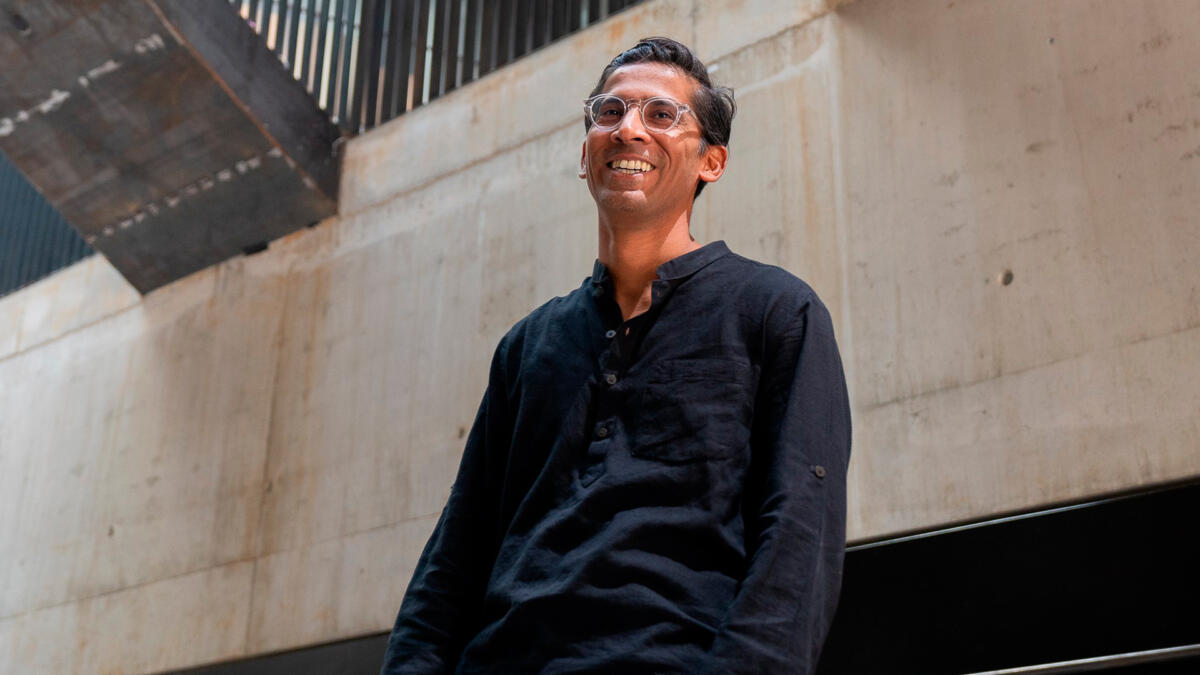Researcher Samir Bhowmik: “Art can be deployed as a method of critical questioning in the way we live, work, and consume”
“Art can be deployed as a method of critical questioning in the way we live, work, and consume. Artworks should be provocations or multiple critical views of our environmental condition, and not simply solutions.” Read Samir Bhowmik’s interview.

How are the themes, questions or practices of ecological sustainability visible in your own work or studies?
We are dealing intensely with the questions of ecological sustainability in both my research and teaching at the Academy of Fine Arts. My Academy of Finland funded project Terra-Performing (2022-27) deals with extractivism and environmental damage through intelligent performance research. We are exploring the infrastructural and environmental footprints of contemporary performance that is augmented by artificial intelligence and automation. Our goal is to find sustainable and participative processes and systems for contemporary performance.
Secondly, I am teaching a course called Ecological Thinking that is in its second year, dealing with extractivism, environmental data and artistic practices. The course acts as a theory and practice studio to engage with ecological sustainability and for fostering emerging artist-researchers from the Academy of Fine Arts who are interested in environmental art practices. This academic year 2022-2023, we have collaborated with Aarhus University in Denmark, Helsinki Biennial 2023 and Uniarts Helsinki Research Pavilion.
Why do you think ecological sustainability is important or interesting in your own work or studies?
Ecological thinking for me has been a natural progression from the study of cultural infrastructures and advanced technologies to their entanglements with environmental change. My research and practice investigate macro environmental issues that are today escalated by rapid technological advancement. Here, the confluence of environmental data, cultural techniques, Artificial Intelligence and automation are probed by artistic and performance research. This has allowed for a critical understanding of the relations between ecology and art, between environment and cultural techniques, and between intelligent performance practices and environmental impacts of digital infrastructures. In my opinion, the current digital age (and ecological crisis) requires artistic research and practice to dive within other disciplines including sciences in computing, engineering, and the natural sciences.
What is or should be the role of Uniarts Helsinki in environmental matters?
Uniarts Helsinki should act as a facilitator of critical questioning of the contemporary environmental condition in both teaching and research. It should act as a multidisciplinary connector across various schools, departments, and external organizations to gather them in its space for discussion. It must strive to be a forum of diversity of alternative views, art-science and cultural practices. Undoubtedly, the environment crisis is not a local issue but technological and global, in fact it is the Global South which is most affected by the technology and consumption of the developed nations. Hence, international cultural exchange in environmental matters would be necessary, especially multi-disciplinary scholars and artists from the Global South could advance ecological thinking in artistic research and practices.
The fourth goal in Uniarts Helsinki’s strategy is that “art is part of the solution to the ecological sustainability crisis”. What thoughts does this evoke? If art is or was part of the solution, what do you think it could mean in practice?
Art, unlike other disciplines, is about questioning the normal and the contemporary. In itself art is not a solution to any problem. The goal of art is the destabilization and rethinking of norms and practices that are harmful to the environment. Art can be deployed as a method of critical questioning in the way we live, work, and consume. Artworks should be provocations or multiple critical views of our environmental condition, and not simply solutions. Thus, artistic research must be reflective and processual (and not final exhibition products) and address the continuously changing environment. In the same way, teaching in art should also be about encouraging processes, criticality and challenging societal benchmarks.
What kind of art has influenced you? How? You can give an example.
The advancement of technology has also given rise to environmental problems. Art that addresses the emerging environmental issues connected to technology interests me. For example a project by the Unknown Fields Division (UK) called “Rare Earthenware” is an excellent example where art or artistic practice meets technology and environmental damage. Vases are made or constructed from toxic earth which were poisoned by the chemical emissions of smartphone polishing factories in Inner Mongolia. The artwork here is a provocative example forcing us to question the manufacturing of modern technologies that cause environmental damage in the Global South, whereas we in the Developed nations such as Finland are conveniently distant from that ecological damage. In other words, art that is a combination of art and science, with a global appeal, in this way questions or rather lays bare our modern desires that conflict with ecological sustainability.
You can answer this if you want to get to know the environmental programme of Uniarts Helsinki: what is most important to you in the environmental programme?
Developing a multi-disciplinary international arts curriculum towards ecological sustainability is an important task. Master’s and Doctoral programs combining ecological thinking and artistic research would be a necessary step forward. Uniarts Helsinki should develop and offer Bachelor’s and Master’s in “Arts and Ecology” as a focused theme of studies within its Bachelor’s/Master’s/Doctoral programs. I would be glad to participate in such an initiative.